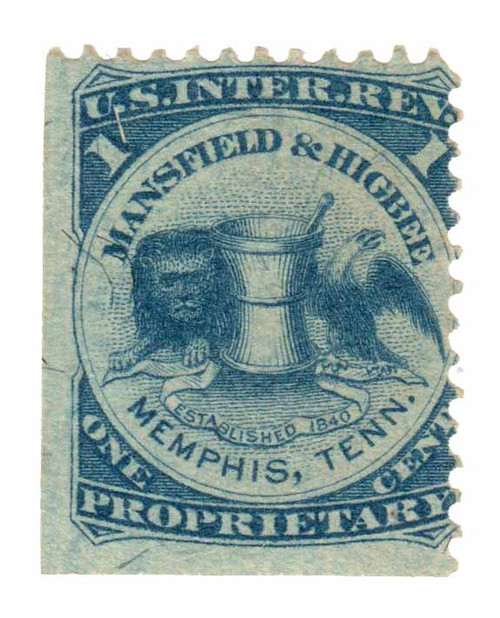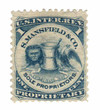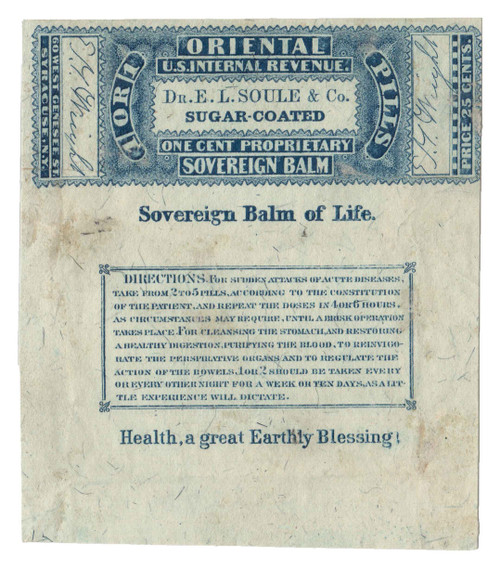
# RS174b - 1871-77 Mansfield & Co, 1c blue, silk paper
US #RS174b
1875-82 S. Mansfield & Co. Private Die Medicine Tax Stamp
• Covered the Proprietary Tax rate for medicine
• Produced by S. Mansfield & Co. of Memphis, Tennessee
• Printed on silk paper – many destroyed in the process of use, making them scarce today
Stamp Category: Private Die Proprietary Tax Stamp
Company Using the Die: S. Mansfield & Co. of Memphis, Tennessee
Value: 1¢ Medicine Tax
First Day of Issue: 1871-77 (?)
Quantity Issued: 1,399,500 (total of those printed on silk, pink, and watermarked papers)
Type: Silk paper
Color: Blue
Why the stamp was issued: To cover the 1¢ tax to be paid on medicine.
About the stamp design: Pictures a fairly simple frame design with a central image of a mortar and pestle flanked on either side by a lion and an eagle. The text on the stamp reads “U.S. Inter. Rev.,” “One Cent,” “Proprietary,” “S. Mansfield & Co.,” “Established 1840,” and “Sole Proprietors.”
Special design details: This stamp was printed on silk paper, which was used to print many early Revenue stamps and a handful of Private Die Proprietary stamps. Silk paper has rag fibers scattered over the paper during its manufacture and then impressed on the surface rather than mixed into the paper pulp like regular-issue stamps printed on silk paper.
Earlier Version of the Stamp: This stamp is the second with nearly the same design. The first had the words “Mansfield & Higbee,” “Memphis, Tenn.” Instead of “S. Mansfield & Co.,” “Sole Proprietors.” This is because Samuel Mansfield had previously partnered with Hugh H. Higbee (1870-1875) to produce his medicines. Mansfield ended the partnership in 1875, leading to the change of the stamp design.
History the stamp represents: The United States issued its first Revenue stamps in 1862 to help fund the Civil War (although the stamps continued to be issued long after the war ended). This included Proprietary Tax stamps covering taxes on medicines, matches, perfumes, and much more. The taxes required for each different type of item were laid out in Schedule C of the 1862 Tax Act.
Later on, the federal government began offering tax discounts to manufacturers who produced their own Proprietary Tax stamps. The manufacturers paid for the engraving and printing expenses while the printing dies were controlled and approved by the US Department of the Treasury. Since each individual company determined the design of their stamps, they often used them as miniature advertisements for their products.
Samuel Mansfield began his apothecary in Memphis, Tennessee, in 1840. He partnered with Hugh H. Higbee in 1870 and had Higbee manufacture his medicines. Some of the most well known included “Mansfield’s Hungarian Balsam for the Lungs,” “Mansfield’s Eclectic Pile Salve,” and “Mansfield’s Mississippi Diarrohea Cordial.” In 1875, Mansfield returned to being the sole proprietor of his business.
US #RS174b
1875-82 S. Mansfield & Co. Private Die Medicine Tax Stamp
• Covered the Proprietary Tax rate for medicine
• Produced by S. Mansfield & Co. of Memphis, Tennessee
• Printed on silk paper – many destroyed in the process of use, making them scarce today
Stamp Category: Private Die Proprietary Tax Stamp
Company Using the Die: S. Mansfield & Co. of Memphis, Tennessee
Value: 1¢ Medicine Tax
First Day of Issue: 1871-77 (?)
Quantity Issued: 1,399,500 (total of those printed on silk, pink, and watermarked papers)
Type: Silk paper
Color: Blue
Why the stamp was issued: To cover the 1¢ tax to be paid on medicine.
About the stamp design: Pictures a fairly simple frame design with a central image of a mortar and pestle flanked on either side by a lion and an eagle. The text on the stamp reads “U.S. Inter. Rev.,” “One Cent,” “Proprietary,” “S. Mansfield & Co.,” “Established 1840,” and “Sole Proprietors.”
Special design details: This stamp was printed on silk paper, which was used to print many early Revenue stamps and a handful of Private Die Proprietary stamps. Silk paper has rag fibers scattered over the paper during its manufacture and then impressed on the surface rather than mixed into the paper pulp like regular-issue stamps printed on silk paper.
Earlier Version of the Stamp: This stamp is the second with nearly the same design. The first had the words “Mansfield & Higbee,” “Memphis, Tenn.” Instead of “S. Mansfield & Co.,” “Sole Proprietors.” This is because Samuel Mansfield had previously partnered with Hugh H. Higbee (1870-1875) to produce his medicines. Mansfield ended the partnership in 1875, leading to the change of the stamp design.
History the stamp represents: The United States issued its first Revenue stamps in 1862 to help fund the Civil War (although the stamps continued to be issued long after the war ended). This included Proprietary Tax stamps covering taxes on medicines, matches, perfumes, and much more. The taxes required for each different type of item were laid out in Schedule C of the 1862 Tax Act.
Later on, the federal government began offering tax discounts to manufacturers who produced their own Proprietary Tax stamps. The manufacturers paid for the engraving and printing expenses while the printing dies were controlled and approved by the US Department of the Treasury. Since each individual company determined the design of their stamps, they often used them as miniature advertisements for their products.
Samuel Mansfield began his apothecary in Memphis, Tennessee, in 1840. He partnered with Hugh H. Higbee in 1870 and had Higbee manufacture his medicines. Some of the most well known included “Mansfield’s Hungarian Balsam for the Lungs,” “Mansfield’s Eclectic Pile Salve,” and “Mansfield’s Mississippi Diarrohea Cordial.” In 1875, Mansfield returned to being the sole proprietor of his business.








